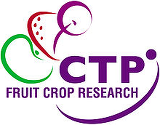October 2019 – September 2023
Catherine Chapman

Catherine studied at the Open University for her BSc and MSc. In her PhD project, she will study the associations between terrestrial C sequestration capacity and genotype-specific apple rootstock traits, including recalcitrance, rhizodeposition, and the associated rhizosphere microbial communities. This knowledge will then enable growers to select rootstocks with greater ecosystem service capacity, in terms of their C storage abilities, which will benefit soil fertility and promote the capture of atmospheric CO2.
She will assess a selection of widely-used apple rootstock cultivars for their C-sequestering abilities by analysing three key components:
- Physical root measurements: Root recalcitrance will be assessed using biochemical methods to quantify various compounds (e.g. total C, soluble phenolics, condensed tannins, acid-insoluble fractions (lignin)). Additional measurements will be made for root thickness, decomposition rate, and root depth distribution using rhizotrons, intact cores (Dornbush, et al., 2002) and incubation of roots in microcosms.
- Root exudate biochemical analysis: Rhizodeposit collection may be done either by a collection of percolated (run-off) water from pot-grown rootstocks (Leisso, et al., 2017), or by dipping roots of axenically-grown rootstocks in distilled water containing silver (Ag+) as described and evaluated by Gransee & Wittenmayer (2000). Primary (sugars, organic acids) and secondary (phenolics) metabolites will be analysed by high-performance liquid chromatography (HPLC) or gas chromatography-mass spectrometry (GC-MS).
- Rhizosphere community analysis: Recent advances in high-throughput sequencing methods have greatly enhanced microbial community analysis. The bacterial and fungal composition of the rhizosphere community will be investigated via amplification of the universal 16S rRNA gene (bacteria) and ITS sequences (fungi). In particular, the project will focus on functional groups related to C cycling, such as methanotrophs (methane producers), methanogens (methane consumers), and AMF.
